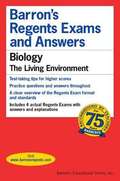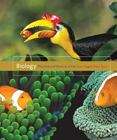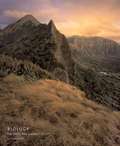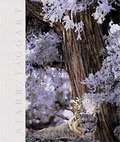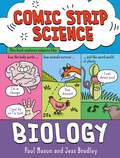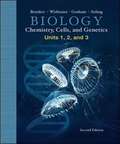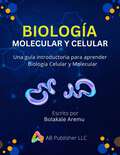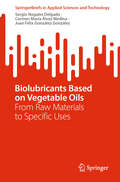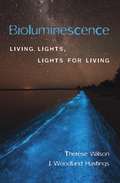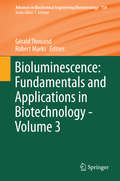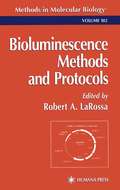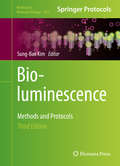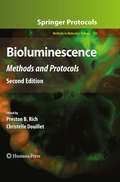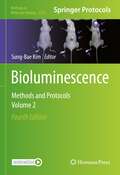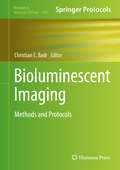- Table View
- List View
Biology: The Essentials
by Mariëlle HoefnagelsThe Essentials epitomizes what the market has come to recognize as Mariëlle Hoefnagels’ distinct and student-friendly writing-style. Mariëlle presents up-to-date information through “What’s the Point?”, “Why We Care”, and “Burning Questions”—pedagogical tools designed to demonstrate to readers, and her own students, that biology is everywhere. Biology: The Essentials, 3nd Edition offers a broader and more conceptual introduction to biology, simplifying the more complex biological content to the essential elements that students need to act as framework for the details. Mariëlle Hoefnagels is dedicated to helping students find the relevancy of biology and science in their everyday lives. A recipient of the University of Oklahoma General Education Teaching Award and the Longmire Prize (the Teaching Scholars Award from the College of Arts and Sciences), Mariëlle has been engaging, educating, and inspiring students since 1997. She believes that the right tools can make all of the difference in reaching non-majors students. Because of this, the content in this textbook is deeply integrated with the digital tools in Connect and Mariëlle has worked hard to create Connect questions and activities that go beyond simply memorizing vocabulary and facts. Static images are brought to life through animated tutorials, specifically designed to guide students through tough topics.
Biology: The Living Environment (Barron's Regents Exams and Answers)
by Gabrielle I. Edwards Marion Cimmino Frank J. Foder G. Scott HunterThis edition includes the most recent Biology Regents tests through August 2011. These ever popular guides contain study tips, test-taking strategies, score analysis charts, and other valuable features. They are an ideal source of practice and test preparation. The detailed answer explanations make each exam a practical learning experience.
Biology: The Living Science
by Kenneth R. Miller Joseph S. LevineThe authors of Biology the Living Science wrote this book to inform, and maybe even to inspire, you about the living science of biology.
Biology: The Study of Life
by William D. Schraer Herbert J. StoltzeTopics covered in this book are: introduction to biology, animal maintenance, plant maintenance, reproduction & development, genetics, evolution, diversity of living things and ecology.
Biology: The Unity and Diversity of Life
by Cecie Starr Lisa Starr Ralph Taggart Christine EversThe 11th edition of this undergraduate text seeks to make students aware of the connection between molecular change, evolution, and students' own lives. To achieve this goal, the text features essays on current controversial issues, links to concepts within and between chapters, two-page concept spreads, and problem solving examples and experiments that encourage students to think critically. Other changes include reorganized and rewritten material on areas such as energy flow and stem cell research. Author information is not given. Annotation ©2006 Book News, Inc. , Portland, OR (booknews. com)
Biology: The Unity and Diversity of Life
by Cecie Starr Lisa Starr Ralph Taggart Christine EversWritten by a team of best-selling authors, BIOLOGY: THE UNITY AND DIVERSITY OF LIFE, 14th Edition reveals the biological world in wondrous detail. This text shows and tells the fascinating story of life on Earth, and engages readers with hands-on activities that encourage critical thinking. Chapter opening Learning Roadmaps help students focus on the topics that matter most and section-ending "Take Home Messages" reinforce key concepts. Helpful in-text features include a running glossary, case studies, issue-related essays, linked concepts, self-test questions, data analysis problems, and more. BIOLOGY: THE UNITY AND DIVERSITY OF LIFE, 14th Edition puts the living world of biology under a microscope for readers from all walks of life to analyze, understand, and enjoy!
Biology: The Unity and Diversity of Life
by Cecie Starr Lisa Starr Ralph Taggart Christine A. EversThe 11th edition of this undergraduate text seeks to make students aware of the connection between molecular change, evolution, and students' own lives. To achieve this goal, the text features essays on current controversial issues, links to concepts within and between chapters, two-page concept spreads, and problem solving examples and experiments
Biology: The Unity and Diversity of Life (10th Edition)
by Cecie Starr Ralph TaggartSuccessive revisions of this book span nearly thirty years and reflect feedback from many instructors and students. This new edition retains the concept spreads and other pedagogical features that are the hallmarks of the book.
Biology: The Unity and Diversity of Life (12th edition)
by Cecie Starr Lisa Starr Ralph Taggart Christine EversThe 12th edition of this undergraduate text seeks to make students aware of the connection between molecular change, evolution, and students' own lives. To achieve this goal, the text features essays on current controversial issues, links to concepts within and between chapters, two-page concept spreads, and problem solving examples and experiments that encourage students to think critically. Other changes include reorganized and rewritten material on areas such as energy flow and stem cell research. Author information is not given.
Biology: The Unity and Diversity of Life (9th edition)
by Cecie Starr Lisa Starr Ralph TaggartThe 9th edition of this undergraduate text seeks to make students aware of the connection between molecular change, evolution, and students' own lives. To achieve this goal, the text features essays on current controversial issues, links to concepts within and between chapters, two-page concept spreads, and problem solving examples and experiments that encourage students to think critically. Other changes include reorganized and rewritten material on areas such as energy flow and stem cell research. Author information is not given.
Biology: The science of animals, plants and the human body (Comic Strip Science #1)
by Paul MasonComic Strip Biology makes learning about the science behind animals, plants and the human body fun! Each spread in this series features a short, funny comic strip that explains a process or aspect of science. Around the comic strip, diagrams and panels give further information on the topic. They are a fantastic way to engage children aged 8 plus with science.The illustrator, Jess Bradey, is winner of the 2021 Blue Peter Award for Best Non-Fiction for A Day in the Life of a Poo, Gnu and You and also writes and draws for The Phoenix Comic. Titles in the series: Biology, Chemistry, Earth and Space, Physics.
Biology: Today and Tomorrow With Physiology
by Cecie Starr Lisa Starr Christine A. EversThe Sixth Edition of BIOLOGY TODAY AND TOMORROW WITH PHYSIOLOGY helps students build critical-thinking skills they will use as responsible, science-literate citizens. Packed with beautiful art and current applications, the book’s straightforward writing style and chunked content help students grasp the fundamentals of biology without overwhelming them with detail. Content updates reflect current research, new technology and the social implications of both, while active learning tools are woven into the narrative and art. This edition works seamlessly with MindTap, featuring Critical Thinking Cases, In-Class Active Learning Resources and Assessable Visualizations. A team of active instructors and subject-matter experts have further strengthened this edition's digital resources with more relevance, engagement and interactive learning opportunities.
Biology: Units 1,2, and 3
by Eric P. Widmaier Robert J. Brooker Linda Graham Peter StilingThis Volume of Biology covers Chemistry, Cell Biology, and Genetics. The Brooker et. al text features an evolutionary focus with an emphasis on scientific inquiry.
Biología Molecular y Celular: Una guía introductiva para aprender biología celular y molecular
by Bolakale AremuEste libro está diseñado para estudiantes que quieran aprender y apreciar temas biológicos básicos mientras estudian las menores unidades de la biología: moléculas y células. La biología celular y molecular es una disciplina dinámica. Hay miles de oportunidades en los campos médicos, farmacéuticos, agricultores, e industriales. Además de prepararte para una diversidad de trayectorias profesionales, entender la biología molecular y celular te ayudará a tomar buenas decisiones que pueden beneficiar tu dieta y salud.
Biolubricants Based on Vegetable Oils: From Raw Materials to Specific Uses (SpringerBriefs in Applied Sciences and Technology)
by Sergio Nogales Delgado Carmen María Álvez Medina Juan Félix González GonzálezThis is a book about biolubricants. It provides a general overview of these useful products, paying attention to their contribution to green and sustainable chemistry or the circular economy through the implementation of biorefineries. But also, it is a book about General Chemistry, Physics, Engineering, etc., as this specific subject could act as a cornerstone for many multidisciplinary fields. The book’s chapters include several exercises and questions to track reader’s learning and give general and specific idea of how biolubricants are not just a promising research topic, but also a practical reality. The main ideas covered in this work are the following: history, origin and use of biolubricants, main chemical routes to produce them and their quality assessment.
Bioluminescence
by Therese Wilson J. Woodland HastingsBioluminescence is everywhere on earth-most of all in the ocean, from angler fish in the depths to the flashing of dinoflagellates at the surface. Here, Thérèse Wilson and Woody Hastings explore the natural history, evolution, and biochemistry of the diverse array of organisms that emit light. While some bacteria, mushrooms, and invertebrates, as well as fish, are bioluminescent, other vertebrates and plants are not. The sporadic distribution and paucity of luminous forms calls for explanation, as does the fact that unrelated groups evolved completely different biochemical pathways to luminescence. The authors explore the hypothesis that many different luciferase systems arose in the early evolution of life because of their ability to remove oxygen, which was toxic to life when it first appeared on earth. As oxygen became abundant and bioluminescence was no longer adequate for oxygen removal, other antioxidant mechanisms evolved and most luminous species became extinct. Those light-emitting species that avoided extinction evolved uses with survival value for the light itself. Today’s luminous organisms use bioluminescence for defense from predators, for their own predatory purposes, or for communication in sexual courtship. Bioluminescence was earlier viewed as a fascinating feature of the living world, but one whose study seemed unlikely to contribute in any practical way. Today, bioluminescence is no longer an esoteric area of research. Applications are numerous, ranging from the rapid detection of microbial contamination in beef and water, to finding the location of cancer cells, to working out circuitry in the brain.
Bioluminescence: Fundamentals and Applications in Biotechnology - Volume 2 (Advances in Biochemical Engineering/Biotechnology #154)
by Gérald Thouand Robert MarksThis book review series presents current trends in modern biotechnology. The aim is to cover all aspects of this interdisciplinary technology where knowledge, methods and expertise are required from chemistry, biochemistry, microbiology, genetics, chemical engineering and computer science. Volumes are organized topically and provide a comprehensive discussion of developments in the respective field over the past 3-5 years. The series also discusses new discoveries and applications. Special volumes are dedicated to selected topics which focus on new biotechnological products and new processes for their synthesis and purification. In general, special volumes are edited by well-known guest editors. The series editor and publisher will however always be pleased to receive suggestions and supplementary information. Manuscripts are accepted in English.
Bioluminescence: Methods And Protocols (Methods in Molecular Biology #102)
by Robert A. LarossaA state-of-the-art collection of innovative methods for the use of luciferase and green fluorescent protein in analytical biochemistry, molecular toxicology, environmental monitoring, and cell-based assays. The contributors-all hands-on researchers who have perfected their protocols to a high degree of reproducibility-illustrate these powerful methods with a wide variety of applications ranging from the analytical determination (titer) of specific molecules to the cellular detection of a wide range of pollutants, to microbiological detection and analysis, and the molecular biological manipulation of lux, luc, and gfp structural genes. Step-by-step methods are also included for the construction of other recombinant organisms.
Bioluminescence: Methods and Protocols (Methods in Molecular Biology #1461)
by Sung Bae KimThis volume presents detailed laboratory protocols regarding the three major route technologies luciferases, efficient optical probes, and applications to visualizing molecular events in living subjects. "Bioluminescence: Methods and Protocols, Third Edition" guides readers through chapters on ingredients of bioluminescent probes, and fabrication of bioluminescent probes, applications to living subjects and instrumentations. Written in the highly successful "Methods in Molecular Biology "series format, chapters include introductions to their respective topics, lists of the necessary materials and reagents, step-by-step, readily reproducible laboratory protocols, and tips on troubleshooting and avoiding known pitfalls. Authoritative and practical, "Bioluminescence: Methods and Protocols, Third Edition" is a useful complement to the first and second edition for new and experienced researchers alike.
Bioluminescence: Methods and Protocols (Methods in Molecular Biology #574)
by Christelle Douillet Preston B. RichThrough the study and application of bioluminescence, scientists have painstakingly harnessed a powerful tool that enables us to seek a deeper understanding of the complex mechanisms underpinning so many vital biologic systems. In this fully revised and updated second edition of Bioluminescence: Methods and Protocols, expert researchers contribute a readable and utilitarian compilation of the newest and most innovative techniques that have emerged in this rapidly expanding and progressively diverse field including methods to assess cell trafficking, protein-protein interactions, intracellular signaling, and apoptosis. Also opening up the possibility to visualize and quantify biological mechanisms in real-time and in in vivo settings, the volume also describes the in vivo study of bacterial or viral infections, transplanted cells, stem cells proliferation, vascular flow, and tumors. Written in the highly successful Methods in Molecular BiologyTM series format, chapters include brief introductions to their respective topics, lists of the necessary materials, equipment, and reagents, step-by-step, readily reproducible laboratory protocols, and notes on troubleshooting and avoiding known pitfalls. Authoritative and cutting-edge, Bioluminescence: Methods and Protocols, Second Edition provides protocols that are detailed enough to be followed and adapted by scientific teams who have no previous expertise in bioluminescence in order to foster the potentially numerous breakthroughs and new applications from basic to applied science and medicine that must continue to be developed.
Bioluminescence: Methods and Protocols, Volume 1 (Methods in Molecular Biology #2524)
by Sung-Bae KimThis detailed collection explores recent advances in molecular imaging techniques involving bioluminescence, currently employed in biolaboratories around the world. Volume 1 delves into techniques for the establishment of luciferins and luciferases, basic in vitro and in vivo applications, as well as protocols on multiplex imaging platforms. Written for the highly successful Methods in Molecular Biology series, chapters include introductions to their respective topics, lists of the necessary materials and reagents, step-by-step, readily reproducible laboratory protocols, and tips on troubleshooting and avoiding known pitfalls. Authoritative and comprehensive, Bioluminescence: Methods and Protocols, Fourth Edition, Volume 1 presents practical guidance for researchers and technical staff on how to proceed with bioluminescence studies in their laboratories.
Bioluminescence: Methods and Protocols, Volume 2 (Methods in Molecular Biology #2525)
by Sung-Bae KimThis detailed collection explores recent advances in molecular imaging techniques involving bioluminescence, currently employed in biolaboratories around the world. Volume 2 delves into techniques for heterogeneous conjugates, protein fragment-complementation assays, BRET-based imaging, as well as instrumentation and software. Written for the highly successful Methods in Molecular Biology series, chapters include introductions to their respective topics, lists of the necessary materials and reagents, step-by-step, readily reproducible laboratory protocols, and tips on troubleshooting and avoiding known pitfalls. Authoritative and comprehensive, Bioluminescence: Methods and Protocols, Fourth Edition, Volume 2 presents practical guidance for researchers and technical staff on how to proceed with bioluminescence studies in their laboratories.
Bioluminescent Imaging: Methods and Protocols (Methods in Molecular Biology #1098)
by Christian E. Badr"Bioluminescent Imaging: Methods and Protocols" distills a wide range of techniques that use bioluminescence imaging as a tool for visualizing and tracking various biological processes. Covering diverse fields such as cellular and molecular biology, oncology, neurology, infectious diseases, immunology, and others, the detailed chapters of this volume are arranged by topic and describe practical procedures and applications of different bioluminescent reporters, from photoproteins (Aequorin) to bacterial luciferases as well as other secreted (such as Gaussia) and non-secreted luciferases (such as Firefly). Written in the highly successful "Methods in Molecular Biology" series format, chapters include introductions to their respective topics, lists of the necessary materials and reagents, step-by-step, readily reproducible laboratory protocols, and expert tips for troubleshooting and avoiding known pitfalls. Authoritative and cutting-edge, "Bioluminescent Imaging: Methods and Protocols" aims to provide diverse and comprehensive techniques to researchers interested in implementing bioluminescence-based imaging in their laboratory, regardless of their previous level of experience with such methodologies.

